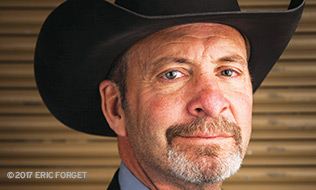
A person will bleed out quickly from a severed carotid artery. But in 1989, when a rogue skate slashed Buffalo Sabres goalie Clint Malarchuk’s artery — injuring his jugular vein in the process — his trainer pinched off the blood vessels until doctors could stabilize him.
Malarchuk ended up losing a third of the blood in his body, and it took 300 stitches to close the wound. Yet he was back on the ice 10 days later.
Read: How to deal with PTSD in the workplace
“As soon as the stitches came out of my neck, I came back,” Malarchuk said at Benefits Canada’s Benefits and Pension Summit in Toronto on April 12. “‘What a stud!’ That town thought I was the greatest. I epitomized everything a blue-collar sports town like Buffalo loves in an athlete. I was a cult hero.”
Missing mental health
While Malarchuk received quality care for the neck injury, his mental health suffered. “Me and the trainer, Jim Pizzutelli, who saved my life, went on the ice in our street clothes and we stood there in the goal crease,” said Malarchuk. “‘This is where it happened.’ ‘Yep, yep.’ ‘You good?’ ‘Yep, I’m good.’ Boom. So that was my counselling. There wasn’t a thing called PTSD back then.”
But Malarchuk wasn’t good. He suffered from panic attacks and nightmares about the accident that were so intense that he didn’t sleep for a week. “Of course, I’m so tough, I didn’t tell anyone,” he said, adding he didn’t want to let his teammates down.
Read: Insurers playing a role amid rising emphasis on mental health
He was eventually diagnosed with obsessivecompulsive disorder, depression, anxiety and panic attacks and prescribed a heavy-duty antipsychotic drug. But his performance suffered, and after a few years, he moved down to the minor leagues. He eventually found a medication that treated his illness successfully, turned to coaching and trained as an equine dentist and chiropractor.
Over time, however, the drug stopped working and in 2008, NHL player Richard Zednik also had his carotid artery slashed during a game, which Malarchuk found triggering. He started drinking more and, a few months after the Zednik incident, he shot himself in the head. The attempted suicide was a wake-up call that led him to spend six months recovering in a treatment centre.
Breaking down barriers
Athletes, soldiers, first responders and others who work in what he describes as tough industries often face more barriers in getting the help they need, Malarchuk noted.
“Being a former player, boxer, rodeo [cowboy], everything I did was so tough,” Malarchuk tells Benefits Canada. “I try to tell people [in tough industries] it doesn’t matter. And these people need to understand that it is not a weakness of any sort. It’s an illness and it can get, most importantly, cured.”
Read: Mental Health Week: Reaching men requires a strategic approach
He urges managers to see mental illness as a disease, rather than a character flaw, and ensure their employees aren’t afraid to ask for help. “They need to hear, ‘Hey, I struggle. It’s OK to struggle. You can get help.’ That’s the biggest thing,” he says.
Malarchuk sees signs his industry has made strides since his accident. “Family, coaches, players, anybody that would be in direct contact with that accident, had access to counselling,” he says of the Zednik incident. “That’s so cool that we’ve come that far.”
Sara Tatelman is an associate editor at Benefits Canada.
Get a PDF of this article.
